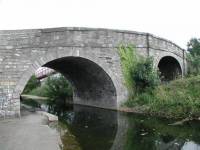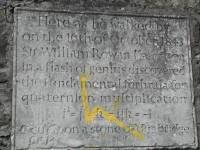- §1. Introduction
- §2. History
- §3. Algebra
- §4. Geometry
History
The quaternions were discovered by Sir William Rowan Hamilton in 1843, after struggling unsuccessfully to construct an algebra in three dimensions. On 16 October 1843, as Hamilton was walking along a canal in Dublin, he realized how to construct an algebra in four dimensions instead. In perhaps the most famous act of mathematical graffiti of all time, Hamilton carved the multiplication table of the quaternions, \begin{equation} i^2 = j^2 = k^2 = ijk = -1 \end{equation} onto the base of the Brougham Bridge as he passed it. Although the original carving is now gone, a plaque marking this historic event appears in its stead (complete with graffiti!), as shown in Figure 1. The inscription on the plaque reads:
Here as he walked by
on the 16th of October 1843
Sir William Rowan Hamilton
in a flash of genius discovered
the fundamental formula for
quaternion multiplication
$i^2 = j^2 = k^2 = ijk = −1$
& cut it on a stone of this bridge
.


Figure 1: The Brougham Bridge in Dublin (left), and the plaque there
commemorating Hamilton's discovery (right).
The quaternions provided the first natural language in which to discuss electromagnetism. The modern language of vector analysis was not introduced until the mid-1880s, by Josiah Willard Gibbs, Oliver Heaviside, and Hermann von Helmholtz. After lengthy disagreement, the language of vector analysis won out, and to this day electromagnetism is taught almost exclusively in the using vectorial methods. 1)
However, quaternions have made a comeback in recent years, as they provide a natural language in which to describe spatial rotations. Quaternions are therefore used in applications such as aeronautics, robotics, and video games.